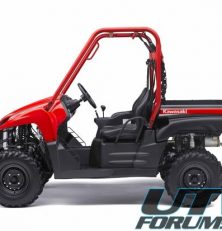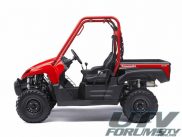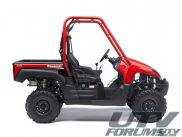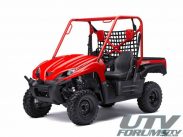KAWASAKI TERYX® 750 FI 4×4 RECEIVES SIGNIFICANT UPGRADES FOR 2009
Digital Fuel Injection, Digital Instrument Panel and Tilting Bed Highlight Changes
A
wide-body chassis, big V-twin power and an efficient CVT hallmark Kawasaki’s impressive line of Teryx® recreation utility vehicles. For 2009, the original Kawasaki Teryx 750 4×4 takes the next evolutionary step with the addition of digital fuel injection and a host of upgraded features.
Superior ground clearance, impressive cargo capacity, and sport handling made the original Teryx one of the most talked-about RUVs on the planet. The addition of a new digital fuel-injection (DFI) system to its mid-mounted 749cc 90-degree V-twin engine adds even more performance and utility to the Teryx, giving it a clear edge over its rivals.
The enhanced response provided by the Teryx’s new digital fuel injection system means its strong and proven V-twin engine is quicker-revving than ever. Kawasaki engineers kept much of the engine’s likeable character when they added DFI, but still found ways to improve it – such as changing the ignition timing to boost low and mid range torque and improve response at higher rpm. Other inherent benefits gained from adding DFI include automatic altitude compensation, automatic idle adjustment and easy, choke-free starting.
The fuel injection system’s sophisticated array of sensors includes an inlet air pressure, throttle position, crankshaft position, rpm, water temperature and a vehicle down sensor. As part of the DFI upgrade, the Teryx also received a new fuel tank with an internal fuel pump. Mated to the engine is Kawasaki’s superb continuously variable transmission (CVT), which transfers the smooth power and quick response from the big V-twin to the wheels smoothly and quickly. The healthy output of this powertrain provides true sport performance, in a controlled manner that allows the driver to harness the full potential of this impressive vehicle. The CVT also received refinements for 2009. Both the intake and exhaust cooling ducts were revised to better prevent water or mud from entering the drive belt area. The new intake duct flows air to the CVT more effectively for better cooling while the intake air temperature is reduced via heat shielding on the exhaust pipe located below the intake duct.
Throttle Position Sensor (TPS) data was added to the CVT Belt Protection System’s sensor inputs. Other inputs include a gear sensor (not in neutral), vehicle speed (measured from the rear wheel), and engine speed. The extra input permits the system to better prevent tire freewheel and offer upgraded rock section performance with less belt overloading. Should the system detect engine operation at high rpm for more than two seconds while the rear wheels remain motionless (i.e. rear wheels are immobilized and the belt is slipping), it automatically retards ignition timing and warns the rider via a flashing belt warning lamp. Power is nothing without control — big power demands a chassis to compliment it and once again the Teryx delivers with an ideal body width that is narrow enough to be useful and able to navigate most trails, yet wide enough to offer a roomy cab and additional stability. The wide track Teryx 750 FI 4×4 design exploits a large-diameter, thin-walled tubular frame offering the necessary rigidity without performance draining weight. It also meets SAE regulations as a roll-over protective structure (ROPS) with an arrangement spacious enough to comfortably fit two full-sized adults.
The Teryx 750 FI 4×4 shares the long A-arm and narrow frame concept of its sport ATV brethren to give it the maximum travel while minimizing wheel camber change. For 2009, the adjustable Kayaba gas-charged shocks have revised settings combined with a new stabilizer bar to improve ride quality. Combined with the mid-ship engine, the balanced package offers superb control and cornering performance, even at top speed. When the terrain requires it, the driver can activate 4WD with a simple servo-control switch. Further traction management is achieved via an ATV-style front differential control activated with a hand lever that lets the driver select how much the wheels are locked together. The rear wheels stay locked and always turn together — much like a sport ATV — allowing the Teryx to slide around corners “drift” style.
It continues its dominance in the field with 26-inch Maxxis tires developed specifically for the Teryx 750 FI 4×4 that enable superb forward and sliding traction. The tall tires offer good rough terrain handling and contribute to its class leading ground clearance and ability to overcome obstacles.
A powerful RUV wouldn’t be much fun without equally capable stopping power and Teryx 750 FI 4×4 delivers. It employs a combination of dual 200mm discs up front and a sealed wet brake in the rear. The front brakes are tucked into the wheels for protection from debris and their 27mm twin-piston calipers are rigid-mounted for optimum feel and control. The advantage of the sealed rear brake is most apparent when it’s able to keep working even in the wettest or muddiest of environments. Its compact profile further adds to the remarkable amount of ground clearance.
Of course, this substantial performance is matched by Kawasaki’s legendary durability and reliability that starts on the surface – tough scratch resistant Thermo-Plastic Olefin (TPO) bodywork, that is. Standard skid plates help shield the Teryx’s engine and undercarriage from ride stopping obstacles.
Inside, bucket seats and retractable three-point seat belts help the driver and passenger stay relaxed; the Teryx 750 FI 4×4 has plenty of shoulder and leg room to provide a comfortable driving environment. Standard equipment on all Teryx models, the new multi-function digital meter adds a fuel gauge and parking brake indicator to the standard hour meter, clock, odometer, dual trip meters and warning lights. However, the Teryx 750 FI 4×4 isn’t all play and no work. Its standard 500-pound cargo capacity and gas-assisted tilting cargo bed are ideal for recreational users, yet versatile enough for work and hauling. A cargo net and tie down hooks in all four corners keep the goods secure. Its 1,300-pound towing capacity expands those cargo abilities further.
When the sun drops the action doesn’t have to stop thanks to dual 40W headlights showing the way and dual rear taillights letting it be seen. A 7.4-gallon fuel tank allows the Teryx to operate longer so the journey isn’t cut short either. With such a cargo-carrying and transportability potential, it is an able partner for leisure/recreation activities, such as camping, hunting or day trips.
A large selection of authentic Kawasaki Accessories are available through Kawasaki dealers for the 2009 Teryx 750 FI 4×4. As with all off-highway vehicle recreation, Kawasaki encourages RUV drivers to drive responsibly and to respect the environment.






